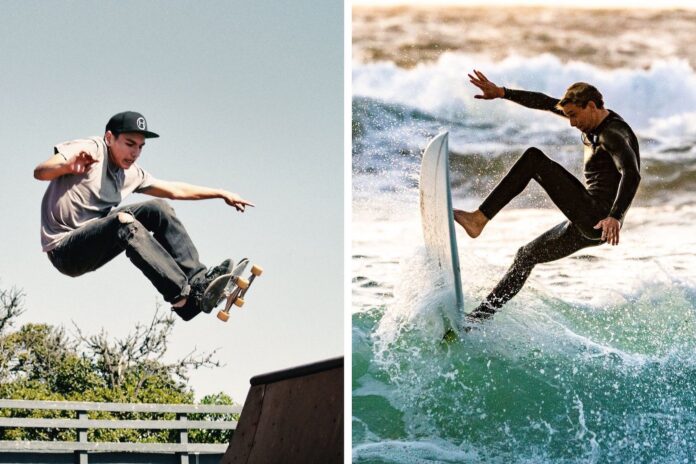Last updated:
A surfer and a skater walk into a bar. After a few beers they argue about which sport is better. They yap about Tony Hawk vs Kelly Slater and kickflips versus tube rides. Eventually the bartender has enough and says “skating is a lot like love… falling is just part of the process…but surfing is like sex: when it’s good, it’s really, really good. And when it’s bad… it’s still pretty good.”
When faced with a difficult question, I tend to deflect with comedy. I hope you laughed, even if nervously.
If you want the ‘too long, didn’t read’ version of this article, then you’ll be happy to know that surfing and skating both rock. But if you had to choose, I’d say pick up surfing. Here’s why:
- A groups of surfers invented skating when the waves were flat
- You can kickflip a surfboard
- Surfing is less dangerous
- More time in big blue nature is great for mental health and your beauty
- More babes at the beach (and bros too)
This isn’t a slam piece on skateboarding, but a few of my friends might toss a pebble under my wheels after they read it. I love to skate, and have room for surfboards and skateboards in my quiver. My favorite thing to do before I go for a surf is ollie around, smash a few curbs, and take the piss out of my neighbors. And there’s plenty of virtue in skating because it can improve your surfing.
OK. Enough. All apologies aside, lend me an ear and I’ll tell you why surfing is a better lifestyle choice.
Surfing started skating
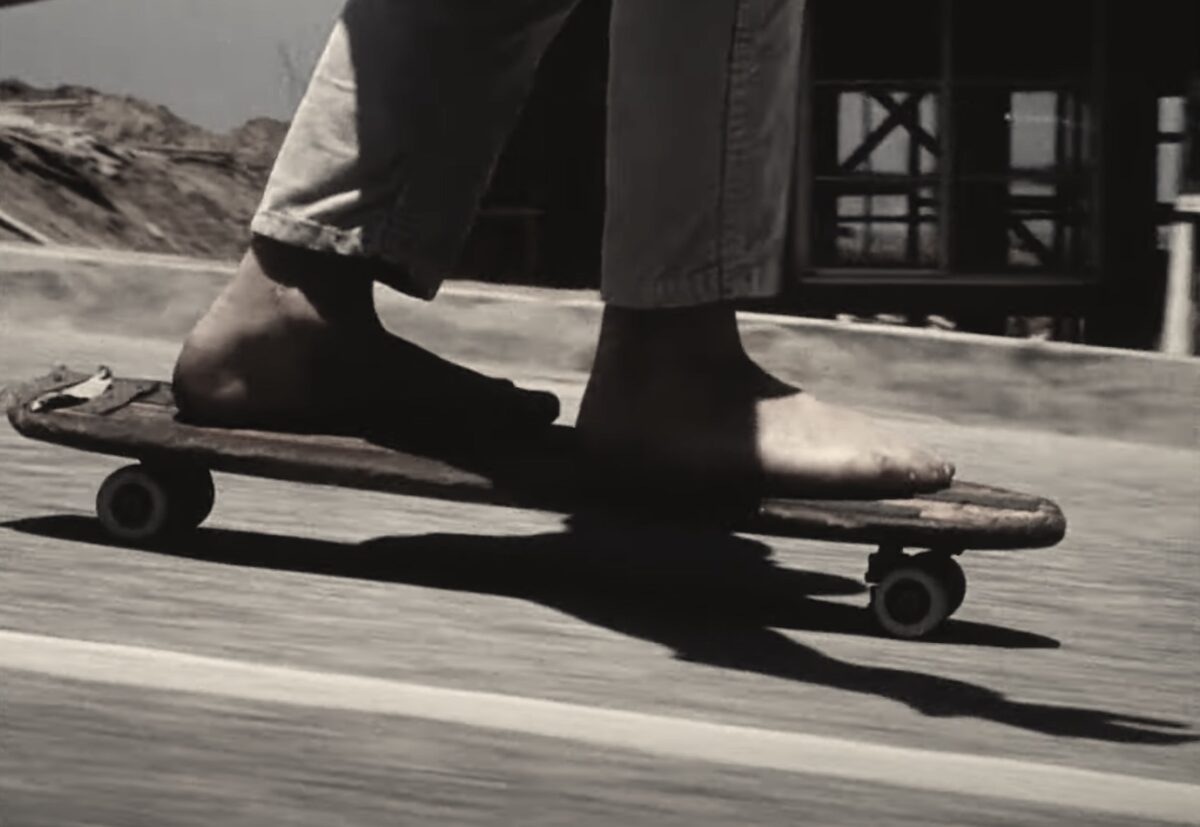
“Surfing started skating.” These were once the words of legendary surfer and manufacturer Herbie Fletcher. And they’re true. The history of skateboarding and the invention of the skateboard can be traced back to California circa the 1950s — likely during a time when the waves were flat. Rollerblade wheels were attached to plywood, and “surf skating” was born.
Riding the concrete waves was an emulation of surfing in the ocean. The style of the skateboards and the style of skating looked a little different than what you see today. Instead of huge airs, flip tricks, or any of the sorts of tricks you’d see in the bowl or at the park, skaters stuck to the streets and tried to carve like they were on a wave.
Skating eventually took off and as legends like Rodney Mullen perfected the ollie and the kickflip — and a group of pool skaters like Tony Alva started boosted frontside airs. The modern acrobatic type of surfing you see in the WSL today was birthed from skating, which was birthed from surfing. The two are in a feedback loop, dancing around one another. But skating can always thank its cool older sibling surfing for showing it the ropes.
The pros and cons of surfing at a glance
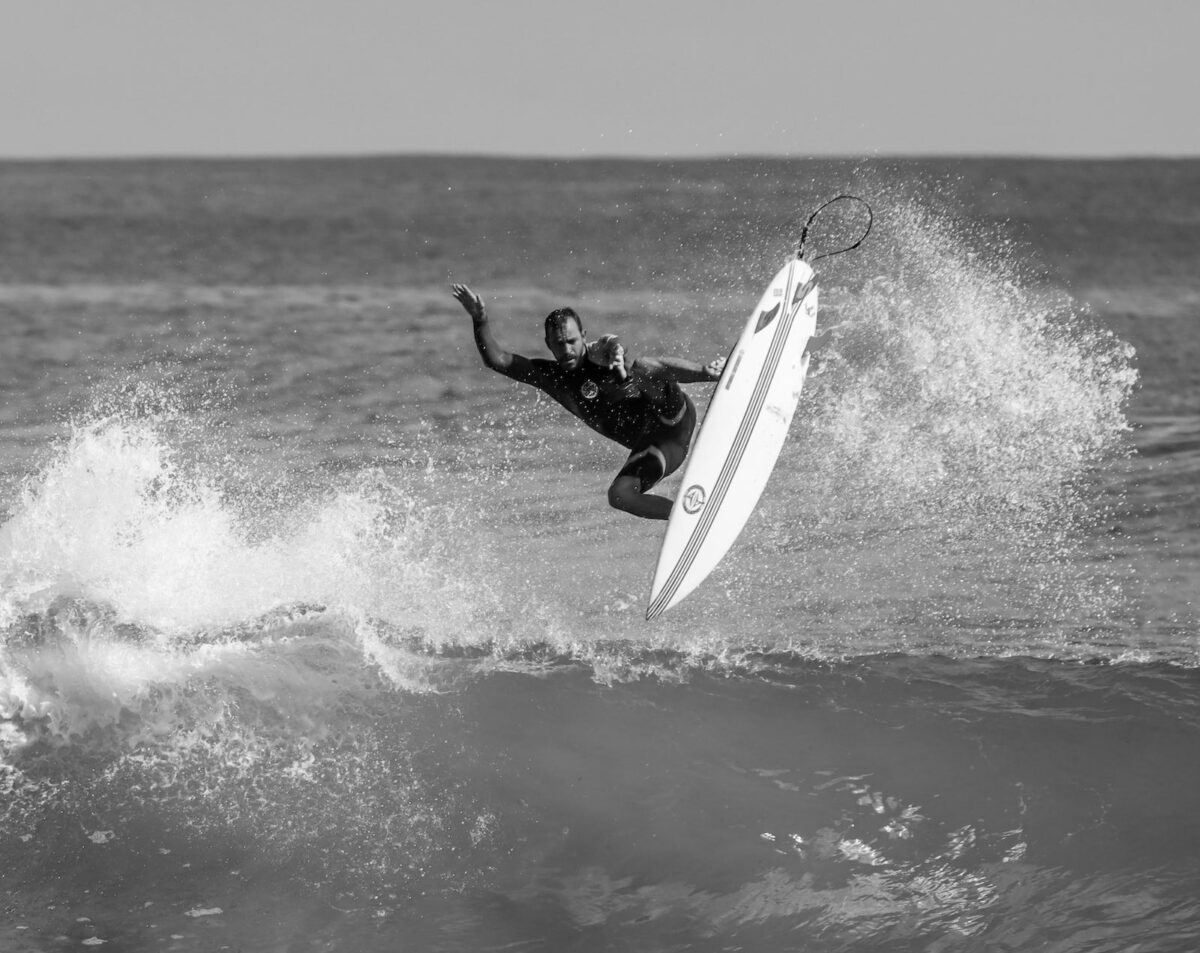
If you know any surfers or are one, then you know that they’re completely obsessed with it. They’ll talk surf, ditch plans to go surf, and even dream about surfing. You might wonder what the hype is all about. Here we outline the pros and cons of surfing, including the learning curve and the equipment you need to get started.
Overview:
Pros:
- Good for your health
- Time spent in blue spaces = mental health therapy
- Riding a wave is the best feeling ever
Cons:
- Territorial (a pro if you are a local)
- Must live near coast or be willing to travel to one
- Sort of expensive
Learning curve:
- Forgiving
- Harder to progress past the beginner stage, easier to progress to higher levels
- The ocean is a beast of burden to navigate
Equipment:
- Surfboard and wetsuit (or just swim trunks if tropical)
- you need a bike, a car and gas, or a plane (sometimes all three) to get to the surf
- Wax, leashes, and everything else are cheap or can be bummed in the car park
The surfing breakdown
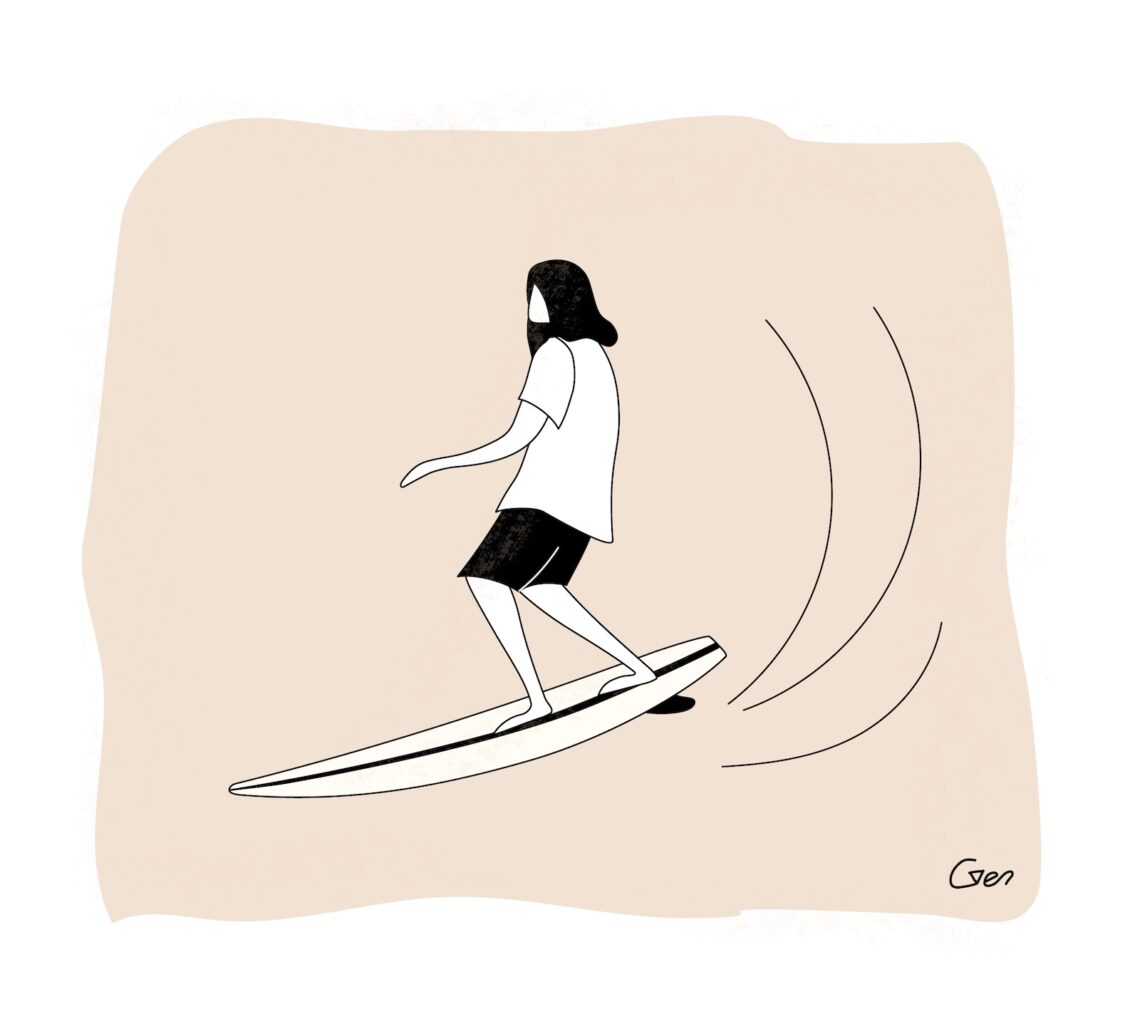
There are many pros to surfing in terms of physical and mental health. For starters, surfing is a sick full body workout that — when combined with the whole foods surfer diet — will get you those much desired washboard abs. Many dream of the surfer’s body. Surfing, and generally spending time in blue spaces, has also been demonstrated to boost mental health. Of course, being a beach bum also has added benefits like exfoliating your skin, giving you a boost of vitamin D, and even promoting hair health. That’s why they call em’ beach babes. If you are single, the beach is a great place to meet a guy or a girl. Everyone is tan and frolicking in the sun — usually with a couple beers! There’s a reason that everyone wants to go to the beach on the weekends: it’s fun in the sun for everyone.
Then there’s wave riding. Riding a wave is a feeling that’s second to none. You are the Silver Surfer, gliding through the universe across this translucent and awe inspiring oceanic medium on your board of power. It’s so simple, stand there and look cool. It’s pretty easy to make surfing look cool because everything else around you — the ocean, the animals, the coastline, the sky — is doing the work. Just have a sleek stance and stand natural.
There are a few cons to surfing though. For starters, surfers at certain locations are known to be territorial, but it is not as bad as it used to be. You might get a mean look or even asked to leave a spot if you aren’t from there / do not give proper respect. But it depends on where you go. In California, you’d get this treatment at less than 10% of the waves. It’s really at select spots. I’d say angry locals are the minority these days though. But there’s a difference between a salty dog and a local who wants to uphold respect — be humble.
This might sound like a pure con, but localism is actually important for protecting the local breaks and allowing local kids to get waves as surfing continues to rapidly grow in popularity. I love seeing an uncle or dad push their 6-year-old into a wave and seeing that kid’s ear-to-ear smile. I don’t need to see anyone (new and clueless or skilled and angry) interrupt a moment like that. And if you learn to respect the unwritten rules of surfing, people will notice your respect and welcome you with open arms and give you the lay of the land.
The other cons of surfing are really about accessibility. If you don’t live near the coast, it can be expensive to drive or fly in order to access a wave. On top of that, the equipment can get pricey unless you know your way around a bargain, but more on that later.
In terms of the learning curve, you have to know how to swim before you can surf. If you grow up swimming and surfing, then it’ll feel second nature. But for someone with no experience it can seem scary and intimidating. The ocean is no joke a force of nature and will swallow you if you don’t tread wisely and with caution. Despite all of this, surfing is actually pretty forgiving and safe, and plenty of people stand up in the white water on their very first day / lesson. Falling in the ocean doesn’t usually leave a mark, which is conducive for falling. But it might take an adult learner a bit of time to progress past the beginner stage, as the goal is to learn how to navigate bigger surf and surf parallel to the shore and not straight into it.
You generally only get a little bit of time on the board surfing. For those who don’t surf, you may be surprised to learn that you spend less than 10% of your time actually on the board riding waves. Surfing is more about paddling and navigating the lineup than anything. This is why it is such a good workout. It could take someone a year or so to actually get the hang of surfing parallel to the shore and learning to navigate the different types of surf that are available.
But once you are on the way, you might experience a much quicker learning curve as you enter the intermediate stages and start to learn how to turn or even get barreled. I can recall a friend who was learning and he was just starting to duck dive and take off with the face of the wave. I went away for my hockey season (~8 months) and when I came home we went surfing. My buddy was sort of ripping, even getting pitted — dropping his wallet and picking up the money in the barrel (in Makua Rothman voice). In 8 months he went from a beginner to a mid-level intermediate.
In terms of equipment, surfing can get pricey fast if you don’t know what you’re doing. A surfboard and wetsuit combo can run you well over $1,000 USD. If you do not live on the shore, then you’ll need a car or a bike to get there. If you are a surfer with surf friends, you’ll inevitably take a surf trip and then fly somewhere and either try and bring your stuff on the plane or buy stuff when you get there. Are you getting the point? But that’s if you want to pay the sucker’s price for equipment. There are some tricks of the trade to get by on nice equipment without breaking the bank.
Get a nice wetsuit and learn to take care of it. I’ve had wetsuits last for 3-5 years. Once it starts to fall apart, learn how to use neoprene cement to patch your suit and keep it going. You really don’t need a new one that often, you just need to get crafty. In terms of surfboards, go on Craigslist or Facebook Marketplace. It will blow your mind the deals you’ll find there. I got a 6’8’’ Lost Mayhem thruster (hand shaped for Shane Beschen!) for $50 and a 6-pack of beer. It needed a minor ding repair and now it’s my go to step-up board for San Francisco winters. Again, learning how to do repairs is not only fun and good for your brain, it’ll save you a ton of money in surfing. I learned to repair wetsuits and even make my own surfboards from youtube and by asking local shop owners for advice. You’ll meet amazing people who are willing to help you learn the tricks of the trade.
Finally, surfers are pros at mooching. You can always bum wax from a stranger, or a leash from your buddy.
The pros and cons of skating at a glance
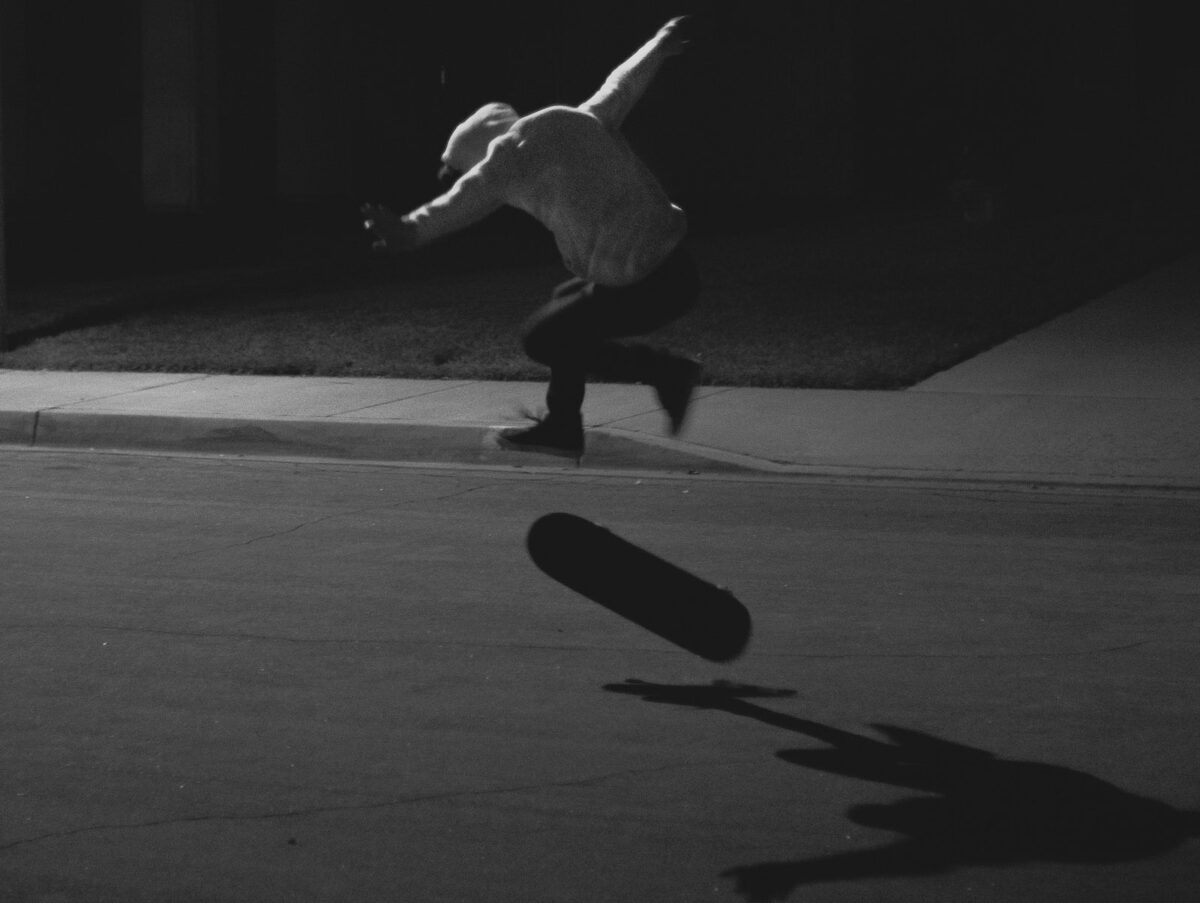
Skaters are cool. They have cool clothes and flirt with industrial danger like it’s the breeze. Despite its grungier roots and looks, skaters are actually some of the most friendly people. Here we outline the pros and cons of skating, including the learning curve and the equipment you need to get started.
Overview:
Pros:
- Can skate anywhere on land
- No strangers
- Duals as transportation
Cons:
- Falling sucks and maims
- Very hard to do tricks
- Societally unreasonable to learn after your youth
Learning curve:
- Unforgiving
- Easy to progress past the beginner stage, harder to progress to higher levels
- Small mistakes lead to grave consequences
Equipment:
- Skateboard deck, bearings, trucks, wheels, grip tape, and a nuts and bolts will get you off the wall and riding
- Pads and a helmet are often compulsory
- Shoes
The skating breakdown
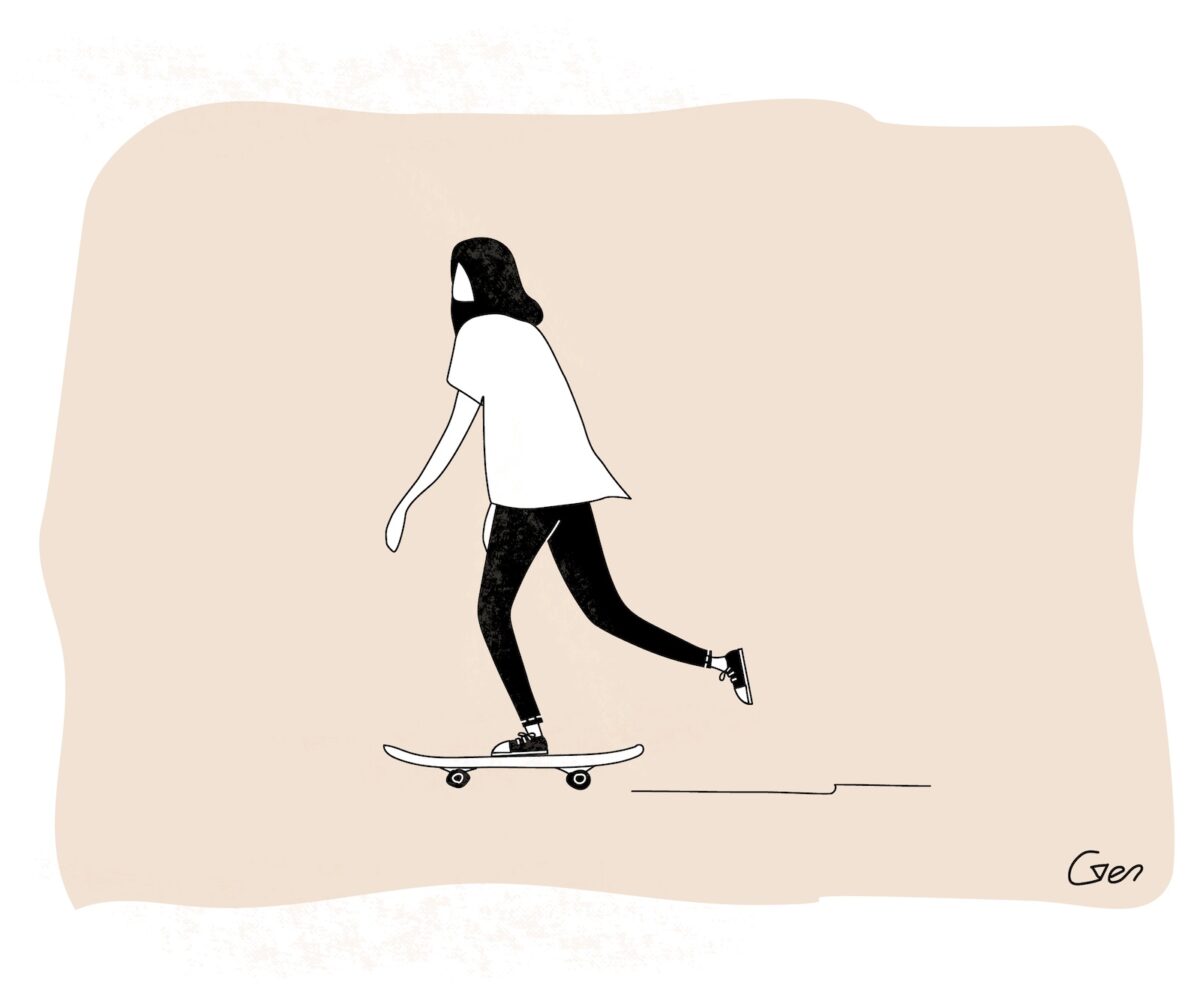
While skating is a damn good workout, I’ve never heard of a “skater’s body.” Unless you’re talking about Will Ferrell in Blades of Glory. Go ahead, drink it in.
The pros of skating center more around accessibility. You can skate literally anywhere on land. It’s impressive how a skater can look at a little ledge and an angled wall of a city building and see this epic line in their mind and then go make it happen. You can skate the sidewalk, a curb, a parking lot, a drained pool, inside the airport, on a tennis court, a skate park, the stairs to a building, any wall, a bench, and on and on. Hell, if you just use the deck of your skateboard (carpet board) you can skate in the grass or on a rug at home. Hop a fence, go skate. It’s fun. You can also take your skateboard to work. I used to work downtown and my favorite part of the day was cruising down this slopey hill all the way to work.
Also, most skateparks are pretty friendly. Of course there’s punks, but for the most part I’ve found that skaters are supremely friendly to just about everyone. You’ll see teens literally holding the hands of young kids as they teach them to drop in. I’ve learned a few tricks I was struggling with because someone much better than me sparked up a conversation and gave me a subtle tip on foot placement and how hard to flick.
The biggest con of skating is that injury is likely. Falling on concrete is a disaster. Gear up for road rash, sprains, concussions, and broken bones. I have surfed, played hockey, and done combat sports my entire life… and nothing has injured me more than that damn skateboard. Something insignificant to the everyday person — a pebble — is the skater’s nightmare. One moment you are cruising down a hill, then next you are looking up at the sky and wondering why your shoes are in the air. Then splat, you go from 15 miles per hour to 0, shredding your face like cheese on a grater, and your wrist breaks the falls, contorting to an unnatural angle. There’s a million different ways to get seriously hurt skating. A slam can crack a rib or give you a concussion. Mistiming a trick can break a foot or ankle. A simple fall can break your wrist. Then there’s cuts from rusty industrial metal. It’s endless. Skaters get injured and boy are they tough about it.
The other cons about skating revolve around trying to learn as an adult. Tell your friends (or your doctor) that you’re going to learn how to surf at 40 and they will say “oh cool! Send pics.” Tell them that you’re going to learn to skate and they’ll say, “Please don’t.” For some reason, learning to skate in your older years (unless your kid is really into it and you want to do it with them) seems socially unacceptable. I don’t agree with it (more power to you), but peer review don’t lie. Skating has always been associated with its punk, teen roots — add in the fact that it maims people — and you don’t really get an adult friendly sport for newcomers — or at least that’s the perception. Let’s take a look at skating’s learning curve to see what the deal is.
The learning curve of skating is a bit paradoxical. On one end, you can get as much board time as you desire at any level. If you can stand on the board, you’ve got board time. Then you learn to push and cruise. You can do this for hours and hours on end without much restriction. That’s why it is pretty easy to get going as a skater. But progressing to higher levels is not so easy. If you want to learn to drop in, or do any tricks, then you’re going to have to fall. Hell, you are going to fall even as you just learn to cruise. And the more difficult the tricks, the more likely you are to fall. Even the basics — manual, hippie jump, kick turn, revert, ollie, 180, and shuv-its — will take some skin and sprain or break a few joints. Not to mention that learning these tricks are genuinely hard — much harder than learning to turn on a surfboard. When you get injured, you typically can’t skate, or skate with more caution until you heal. Small mistakes lead to grave consequences.
In terms of equipment, skating isn’t exactly cheap, but it’s not bad. You need a skateboard deck, bearings, trucks, wheels, grip tape, and nuts and bolts. You can get all of this for around $70 to $150. Many people wear pads (helmet, knee pads, elbow pads, and wrist guards), which run you another $80. With all of the injuries that happen in skating, pads and a helmet won’t hurt. Finally, skate shoes are somewhat important. You can skate barefoot, but a pair of running shoes might kill you. Most people opt for vans or converse — just a simple flat bottom sneaker. Tack on another $60 to $80. One thing I love about skating is that people just leave old decks behind at the park. Buy a pair of trucks and wheels and just go around picking up old decks. If someone good skated it, you might get some of their powers.
The benefits of doing both
Surf-skate style is the best of both worlds. There’s so many pro surfers who rip at skating and vice versa. Curren Caples is a pro-skater who also is a sponsored surfer. OG pro skaters Tony Alva and Jay Adams both surf. On the surf side, so many great pros — like Kelly Slater, John Florence, Noa Deane, and the late Kalani David — also rip on a skateboard.
If you want to see a great example of people who truly rip in the park and in the water, look no further than brothers Christian and Nathan Fletcher. Both renowned pro surfers, Christian and Nathan have a unique surf-skate style that brings in the aerial game of skating to surfing. Christian actually did the first proper aerials in surfing competitions.
In terms of benefits, I am a true believer that board time is board time. On the surfing side, spending time in the water will enable you to try new things on your board without the cost of the concrete wipeout. You can also think of the wave as a skate bowl or a ramp and practicing dropping in and bombing hills. On the skate side, it can certainly improve performance surfing and how you draw lines. More board time on the skateboard will build comfort and confidence. Learning how to land tricks and doing airs in the park will give you more confidence trying airs on surfboards. When it is flat, go for a skate. And when there’s waves, grab your board and go, go, go.
Conclusion
Surfing and skating are part of the same family. They both invoke feelings of joy from spending time on a board. But if you’re thinking of learning one sport for the rest of your life, then surfing is the better lifestyle choice. Not only do you get a more complete workout, you get the added mental health benefits of the time spent near the ocean and the beauty benefits of nature’s mineral spa. It’s also so much easier on your joints — water lubricates, concrete decimates.
So if you want an activity to enjoy well into your golden years, grab a surfboard and get your stoke on.

